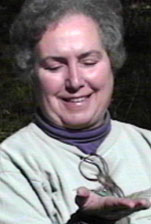 |
Nancy L. Newfield has been watching hummingbirds at her Louisiana home and lots of other places since 1975. Nancy lost her amateur status years ago, and now writes and lectures on hummers. She is co-author of Hummingbird Gardens, reviewed elsewhere on this site. Nancy is also a licensed hummingbird bander and a recognized authority on hummingbird distribution, behavior, and taxonomy. |
December 1996
A Hummingbird Bonanza! (part 2)
Our quest for data has answered some questions, but at the same time, additional questions have arisen - and those answers may not be as easy to determine. We know that Ruby-throateds comprise only a small percentage of the winter population. And those Ruby-throateds are nearly always very young birds that have not put on enough fat to sustain them during a 500+ mile flight across the Gulf of Mexico. We suspect that these youngsters are products of late nests and that they originate farther north. Most of these hummers arrive after a period of days or weeks when no members of their species has been present. Most wintering Ruby-throateds are able to survive the normally moderate southern winters, but returns have been almost zero.The presence of other species raises more questions. Are there more hummers wintering in the southeast, or is the perceived increase a function of increased observers maintaining an increased number of feeders? How many birds are involved? What percentage of the total population are they? Why are they now wintering in the Deep South rather than in their species' traditional wintering areas in Mexico? How are they finding their way? By what route do they travel? How do winter survival rates compare with those that winter in the traditional areas? What role do feeders play?
Answers to these questions will be more difficult to find. And, they won't be found without a major project co-ordinating studies on the breeding grounds, on known migration routes, on the traditional wintering grounds, and in the southeast. Each species should be studied individually, with the greatest emphasis placed on Rufous, Black-chinned, Buff-bellied, Calliope, and Broad-tailed.
Van Remsen, Curator of Birds at the L.S.U. Museum of Natural Science, speculates that feeders in the breeding areas may be fueling population increases. And that the carrying capacity of the traditional wintering grounds cannot support the additional birds, which then have to pioneer new territory. He also suggests that changes in the jet stream in late November may play a role in displacing hummers as many of the wintering birds appear between Thanksgiving and Christmas, more than two months after the bulk of the hummer populations have departed the U.S. and Canada.
My own theory is that habitat loss in Mexico forces many young birds to pioneer because most of the available habitat is taken by members of resident tropical species and by adults of their own kind. Perhaps, young birds arrive on the wintering grounds, then wander around until they've found suitable territory. Perhaps, the progeny of birds that successfully wintered in the southeast are more prone to migrate to the southeastern states. Perhaps, contact with pesticides causes some individuals to become disoriented. Who knows?
I do know that feeders or lushly-planted gardens cannot lure hummingbirds to leave their normal migration routes or wintering grounds because the birds cannot know that they will find reliable food in a distant place. I strongly believe that feeders and gardens make the birds more visible because they are right outside our homes. I believe that removing the feeders will not cause these birds to migrate because they have already migrated considerable distances to reach the southeast. And, I strongly believe feeding these birds enables more of them to survive and return to their breeding grounds.
Banding has demonstrated that the percentage of returning adult birds approaches the rate of returns to nesting areas, suggesting that winter survivors will try to return to the locale where they have wintered before. All this makes the winter season exciting in the Gulf Coast region, where hummingbirders anticipate the winter season like children awaiting Christmas!
In Louisiana, yards that host ten or more individuals every winter are well known. Last winter, several yards hosted more than twenty hummers each. Three or more species are usually represented, with the record being six species in a single yard! And, most of these yards are graciously opened to human visitors as well! What a hummingbird bonanza!
Happy Hummingbirding!
Copyright © 1996
Nancy L. Newfield
Casa Colibri
Metairie, LA